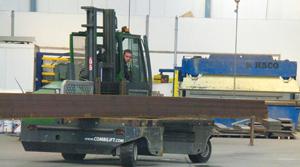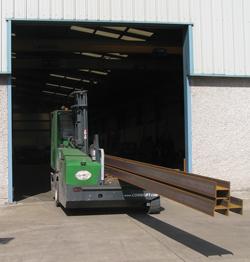Senior Editor
- FMA
- The Fabricator
- FABTECH
- Canadian Metalworking
Categories
- Additive Manufacturing
- Aluminum Welding
- Arc Welding
- Assembly and Joining
- Automation and Robotics
- Bending and Forming
- Consumables
- Cutting and Weld Prep
- Electric Vehicles
- En Español
- Finishing
- Hydroforming
- Laser Cutting
- Laser Welding
- Machining
- Manufacturing Software
- Materials Handling
- Metals/Materials
- Oxyfuel Cutting
- Plasma Cutting
- Power Tools
- Punching and Other Holemaking
- Roll Forming
- Safety
- Sawing
- Shearing
- Shop Management
- Testing and Measuring
- Tube and Pipe Fabrication
- Tube and Pipe Production
- Waterjet Cutting
Industry Directory
Webcasts
Podcasts
FAB 40
Advertise
Subscribe
Account Login
Search
Moving material beyond the Emerald Isle
Irish material handling manufacturer looks beyond the island for growth
- By Tim Heston
- July 13, 2010
- Article
- Materials Handling

Figure 1: A worker at Leonard Engineering, Monaghan, Ireland, uses a four-way sideloader to maneuver a steel beam around a corner.
Visiting Monaghan, I could tell the Irish take pride in their hedges, cut just so, precisely perpendicular to the ground. Their presence exudes tidiness, order, efficiency, taking up no more space than absolutely necessary. The trimmed shrubbery seemed absolutely appropriate along the road leading to one of the area’s largest employers, forklift manufacturer Combilift. The very reason the manufacturer, based in Gallinagh, just outside Monaghan, has grown quickly over the past decade is that its products move just so, fitting precisely into tight racking and taking up no more space than necessary.
Every few years this young company, launched in 1998, invites the world’s trade press to company headquarters. In April more than 100 wordsmiths from 30 countries traveled from as far away as New Zealand and Australia to the picturesque hills of County Monaghan, northwest of Dublin. There, they previewed new products, including the C50,000, a multidirectional forklift designed to handle loads up to 50,000 pounds—or 25 U.S. tons (see Large Product, Big Handling Challenges sidebar). What they also saw was a company that, all things considered, came out of the global economic crisis a little bruised but not down for the count. That’s saying something in Ireland, a country hard-hit by the recent economic turmoil.
“We had a difficult pill to swallow last year," said Martin McVicar, managing director and co-founder of the company. “The worldwide market got hit 50 percent, and we had a slump of 28 percent. This year we hope to be back to 2008 levels." (The other company founder, Robert Moffett, invented the Moffett Mounty truck-mounted forklift, now owned by HIAB.)
The company produces a four-way forklift that can turn on a dime. Actually, “turning" isn’t the right word. The vehicle really just shifts direction. The truck moves forward, stops, turns its wheels 90 degrees, and then move sideways in either direction. The truck body remains in the same orientation. The concept involves a three-wheel design, with a single rear wheel, giving it a zero turning radius. All the wheels rotate up to 180 degrees, allowing it to move forward and backward and side to side (see Figure 1 and Figure 2).
Today the company exports most of its vehicles and keeps much of its supply base local. In other words, it manufactures locally and sells globally, a practice that has won Combilift numerous awards from Irish commerce organizations.
Managing Through a Bust
Ireland, like the U.S., experienced an unprecedented real estate boom and bust. Martin Leonard, managing director of Leonard Engineering, a structural steel fabricator based in Monaghan, not far from Combilift, knows this all too well. His firm, which serves the commercial and industrial building market, grew with the real estate boom. At its peak the company employed 25 and fabricated about 90 tons of steel a week. Now the company processes a fraction of that and has downsized its work force by half.
“We’re going all over the country to work, not just in our local area," Leonard said, explaining much of the work now is government-related, such as library construction. “We’re also doing some work in Northern Ireland, and we’ve even sent some steel out to Australia."
The Australian opportunity happened thanks to an Irish crane company not far from Monaghan. Hurt by the dramatic economic downturn, the crane firm decided to go to one of the few economies in the world not doing too badly. Australia’s mining industry has continued to thrive, supplying nearby China’s growth engine. Some cranes in the Australian fields now have base plates fabricated halfway around the planet, on Leonard Engineering’s 30,000-square-foot shop floor. The base structures are 12 in. thick with 0.625-in. top and bottom plates sandwiching a honeycomb lattice interior.
The Leonard family is known for steel around County Monaghan. His grandfather worked for a time at a Scottish steel mill before returning to Ireland to start a small forge near Ballybay, a little south of Monaghan town, during the early part of the last century. Leonard grew up in the family business before going out on his own in 1976, when he launched Leonard Engineering as a welding repair shop and manufacturer of digger buckets. He gradually grew the business to meet local demand for structural steel, and by 2006 the company shifted into high gear as it rode the Irish real estate boom. Then in 2009—well, you know what happened.
Handling Challenges at Leonard
In 2008 Leonard bought a Combilift SL series, a four-way sideloader model, popular in the European market. The truck can pick up a long beam from a tight space and then transport it where needed, lengthwise through the shop’s door (see Figure 3).

Figure 3: Leonard Engineering uses a four-way sideloader to transport structural beams lengthwise through the shop door.
A typical bundle of beams are brought from the yard and placed on an outdoor roller conveyor, at which point they are transported through the beam line’s drilling and sawing equipment. From there the fork truck plays an instrumental role in material handling, transporting beams between blasting, fabrication, and painting. To move plate, the operator can move the forks in, lift, back out, and then move left or right as soon as the plate clears the rack (see Figure 4).
Leonard Engineering is a different place than it was just two years ago, and the economy has forced the company to change how it orders material. Before the recession its fork trucks would maneuver through a yard full of steel. Now much of the yard is empty. The company orders stock from its steel supplier only when needed (see Figure 5). Inventory can be expensive, something Leonard managers became all too aware of when the price of steel plummeted. Buying stock and then having the price drop by 50 percent wasn’t an ideal situation.
The trucks help Leonard with quick material handling, with fewer people doing more work in lean times. As the recession’s one silver lining, Leonard has held on to its core, experienced staff, trained in all fabrication and erection processes. Every employee is a jack of all trades.
“We still have our first apprentice who came here in 1976," Leonard said. “It’s a delightful staff, and it makes running a business easy."
Large Products, Big Handling Challenges
Computer server farms require some serious cooling, and here is where BladeRoom Group Ltd., a British manufacturer, saw opportunity.
“Servers generate exceptionally large amounts of heat," said BladeRoom CEO Paul Rogers. “The sector is second only to the aviation industry when it comes to energy consumption. Companies have gone to great lengths to cool premises by installing ever-larger air-conditioning units, but these are not very efficient. It’s like having an oven inside of a fridge"—the “oven" being the bank of servers that can quickly heat up its surroundings (see Figure 6).
To help solve the problem, BladeRoom introduced its pre-engineered, factory-built data centers that incorporate computer fluid dynamics to extract the maximum amount of heat with the minimum use of mechanical cooling.
These modules are manufactured within the company’s Cinderford, Gloucestershire, facility. The completed modules are 46 by 14 ft., and maneuvering them isn’t easy. Cranes aren’t practical to use in BladeRoom’s L-shaped building. Also, the sheer size of a counterbalance forklift capable of moving loads of 18 tons at extended load centers would have taken up too much space in the manufacturing area (see Figure 7).
Ultimately, the company bought a Combilift C50,000 four-way fork truck with a three-wheel design—and a capacity of 25 U.S. tons. The unit was delivered shortly after an official unveiling in April during a press event at Combilift headquarters in Ireland. Modules will be placed in rows to allow the fork truck to travel sideways along gangways between them, and the fork truck’s 13-ft. lift height will allow modules to be double-stacked.
About the Author

Tim Heston
2135 Point Blvd
Elgin, IL 60123
815-381-1314
Tim Heston, The Fabricator's senior editor, has covered the metal fabrication industry since 1998, starting his career at the American Welding Society's Welding Journal. Since then he has covered the full range of metal fabrication processes, from stamping, bending, and cutting to grinding and polishing. He joined The Fabricator's staff in October 2007.
Related Companies
subscribe now

The Fabricator is North America's leading magazine for the metal forming and fabricating industry. The magazine delivers the news, technical articles, and case histories that enable fabricators to do their jobs more efficiently. The Fabricator has served the industry since 1970.
start your free subscription- Stay connected from anywhere

Easily access valuable industry resources now with full access to the digital edition of The Fabricator.

Easily access valuable industry resources now with full access to the digital edition of The Welder.

Easily access valuable industry resources now with full access to the digital edition of The Tube and Pipe Journal.
- Podcasting
- Podcast:
- The Fabricator Podcast
- Published:
- 04/16/2024
- Running Time:
- 63:29
In this episode of The Fabricator Podcast, Caleb Chamberlain, co-founder and CEO of OSH Cut, discusses his company’s...
- Trending Articles
AI, machine learning, and the future of metal fabrication

Employee ownership: The best way to ensure engagement

Steel industry reacts to Nucor’s new weekly published HRC price

Dynamic Metal blossoms with each passing year

Metal fabrication management: A guide for new supervisors

- Industry Events
16th Annual Safety Conference
- April 30 - May 1, 2024
- Elgin,
Pipe and Tube Conference
- May 21 - 22, 2024
- Omaha, NE
World-Class Roll Forming Workshop
- June 5 - 6, 2024
- Louisville, KY
Advanced Laser Application Workshop
- June 25 - 27, 2024
- Novi, MI


























